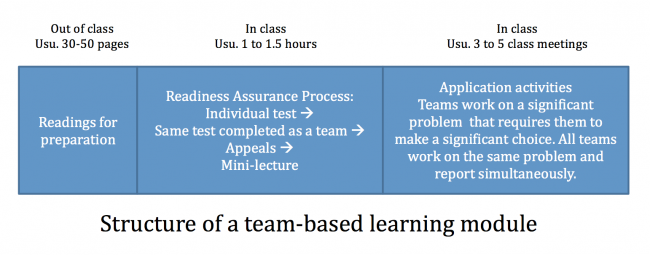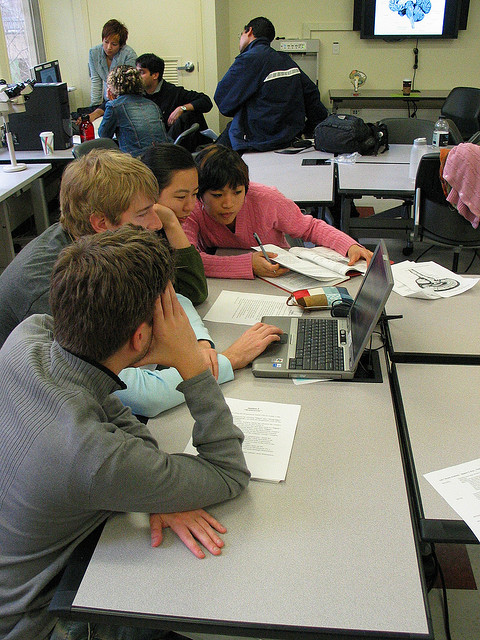Team-based learning
| Print Version |
| Cite this guide: (2013). Team-based learning. Vanderbilt University Center for Teaching. Retrieved [todaysdate] from https://cft.vanderbilt.edu/guides-sub-pages/team-based-learning/. |
What is it?
 Team-based learning (TBL) is a structured form of small-group learning that emphasizes student preparation out of class and application of knowledge in class. Students are organized strategically into diverse teams of 5-7 students that work together throughout the class. Before each unit or module of the course, students prepare by reading prior to class.
Team-based learning (TBL) is a structured form of small-group learning that emphasizes student preparation out of class and application of knowledge in class. Students are organized strategically into diverse teams of 5-7 students that work together throughout the class. Before each unit or module of the course, students prepare by reading prior to class.
In the first class of the module, students participate in a “Readiness Assurance Process,” or RAP. Specifically, students complete a test individually (the “Individual Readiness Assurance Test,” or iRAT);
and then complete the test with their group members (the “group Readiness Assurance Test,” or gRAT). Both the individual scores and the group scores contribute to the students’ grades. The tests are typically multiple choice, and students often complete the group test using a “scratch-off” sheet and score themselves, reducing grading time and promoting student discussion of correct answers.
After the students complete the group test, the instructor encourages teams to appeal questions that they got incorrect. The appeals process encourages students to review the material, evaluate their understanding, and defend the choice they made.
To conclude the Readiness Assurance Process, the instructor gives a mini-lecture that focuses on concepts with which students struggled the most.

Importantly, this work serves as preparation for the in-class application activities that complete the module. These application activities require the teams to make a specific choice about a significant problem. Importantly, all teams work on the same problem and report their decisions simultaneously. This structure requires teams to articulate their thinking, and gives teams an opportunity to evaluate their own reasoning when confronted with different decisions that other teams may make. Peer evaluation is an important part of team-based learning; it is essential for keeping students accountable to their teammates.

L. Dee Fink uses a method in which students are given 100 points to distribute among their teammates (but don’t evaluate themselves). Based on all team members’ evaluations, a student is assigned a score (out of 100) that is used as a multiplier for the score they receive for group activities. Thus, if a team member does not contribute to group activities, her or her score for the group activities will suffer, while a team member who contributes very effectively benefits.
Larry Michaelson uses a variation of this method in which a student evaluates the other members of her team and distributes a set number of points among them. The points the students receive from each of their teammates determine the peer evaluation score that is a direct component of their grade for a given module.
Theoretical basis
Patricia Hrynchak and Helen Batty provide an excellent analysis of the theoretical basis of team based learning (2012).They argue that team-based learning incorporates the main elements of constructivist learning, in which the “focus is on the mental representation of information by the learner” (Svinicki 2004, p. 242; Kaufman 2003):
- The teacher is a guide to facilitate learning.
- Learners should encounter inconsistencies between preconceptions and new experiences to provide a basis for development of new understandings.
- A focus on relevant problems accompanied by group interaction promotes learning.
- Learning requires reflection.
Team-based learning is consistent with all of these elements. The teacher establishes the learning objectives and chooses the problems on which the students will focus but then acts as a guide while teams work toward their solution to the problem. A careful choice of problems can help reveal common student misconceptions, and the constant interaction and debate among team members allows learners to compare their current understandings with those of other team members and to construct new understandings. Group interaction and a focus on relevant problems is an inherent element of team-based learning. Finally, team-based learning provides several opportunities for reflection: during the group readiness assessment test; while hearing other teams’ reports of their conclusions; and during the peer evaluation process, which often includes self-evaluation.
Does it work?
Team-based learning is one version of a flipped classroom, which is supported by a 1998 study by Richard Hake. Hake gathered data on 2084 students in 14 introductory physics courses taught by traditional methods (defined by the instructor as relying primarily on passive student lectures and algorithmic problem exams), allowing him to define an average gain for students in such courses using pre/post-test data. Hake then compared these results to those seen with interactive engagement methods, defined as “heads-on (always) and hands-on (usually) activities which yield immediate feedback through discussion with peers and/or instructors” (Hake p. 65) for 4458 students in 48 courses. He found that students taught with interactive engagement methods exhibited learning gains almost two standard deviations higher than those observed in the traditional courses (0.48 +/- 0.14 vs. 0.23 +/- 0.04).
More specifically, team-based learning has been shown to produce learning gains in a variety of healthcare education classrooms. A selection of those studies are described here.
Levine and colleagues incorporated team-based learning into a psychiatry clerkship curriculum, replacing half of the lectures with TBL activities including readiness assurance tests and application exercises (2004). Following implementation of team-based learning, students performed significantly better on the National Board of Medical Examiners psychiatry subject test. They also scored higher on attitudes about working in teams and reported the team learning activities to be more effective learning strategies.
Paul Koles and colleagues compared medical students’ test performance on questions that assessed concepts learned by TBL methods or by other methods (2010). Students exhibited higher mean scores on questions that assessed knowledge of content learned via TBL than on questions assessing content learned using other methods. Importantly, students within the lowest quartile showed the greatest gains: average improvement of 7.9% for students in the lowest quartile as compared to average improvement of 5.5% for all students.
Zgheib and colleagues investigated the impact of team-based learning for second year medical students in a pharmacology course (2010). They found that team-based learning approaches were more effective than traditional lecture-based pedagogy for improving student learning of difficult concepts but were not more effective for easier concepts.
Where can I learn more?
The best source of information about team-based learning is the Team-Based Learning Collaborative website. The website provides an introduction to TBL, specific information about elements to consider when implementing TBL, and books and articles on TBL.
References
Hake R (1998). Interactive-engagement versus traditional methods: A six-thousand-student survey of mechanics test data for introductory physics courses. American Journal of Physics 66: 64-74.
Hrynchak P and Batty H. (2012) The educational theory basis of team-based learning. Medical Teacher 34: 796-801.
Kaufman DM. (2003). Applying educational theory in practice. BMJ 326: 213-216.
Koles PG, Stolfi A, Borges NJ, Nelson S, Paremelee DX. (2010). The impact of team-based learning on medical students’ academic performance. Acad. Med. 85: 1739-1745.
Levine RE, O’Boyle M, Haidet P, Lynn DJ, Stone MM, Wolf DV, and Paniagua FA. (2004). Transforming a clinical clerkship with team learning. Teach Learn Med 16: 270-275.
Svinicki MD. (2004) Learning and motivation in the postsecondary classroom. San Francisco: Anker Pub. Co.
Zgheib NK, Simaan JA, and Sabra R. (2010). Using team-based learning to teach pharmacology to second year medical students improves student performance. Med Teach 32: 130-135.

This teaching guide is licensed under a Creative Commons Attribution-NonCommercial 4.0 International License.
Photo Credit via Compfight cc